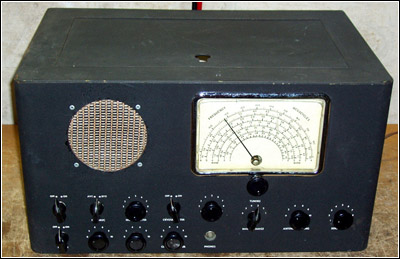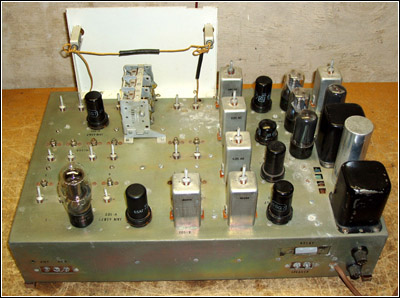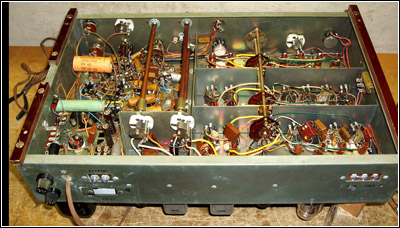Of Old Radios And Related Items--Published Monthly
A U.S. Coast Guard Mystery Receiver
BY JERRY WIELAND
Web Edition
See "full issue PDFs" for complete article
Jerry Wieland is looking for more answers regarding his U.S. Coast Guard receiver. As he says, even knowlegeable friends and the web don't always come up with everything you want to know. (Editor)
On a recent radio hunting expedition, I visited a few resale shops in an old part of Racine, Wisconsin. My brother lives in Racine and introduced me to this area years ago. I found a few radios there in the past, but nothing in recent years. In one store full of all sorts of stuff, I bought a small RCA oscilloscope that actually worked in the store.
After the sale, the owner said he had something else I might be interested in. Under a table I had passed before, pushed to the rear was a black metal communications receiver with an impressive number of knobs and a large dial, as shown in Figure 1. When I opened the top cover which was missing a latch assembly, I counted eleven tubes. There were also many alignment adjustments. Both the tubes and adjustments had corresponding ID labels painted on the chassis, shown in Figure 2. The dial had six bands covering LW, BC, and SW to 19 MHz. After some negotiating, we settled on $25.
Figure 1. The metal Coast Guard communications receiver Model R-138 with many knobs and a large dial.Restoration
Some of the features of this receiver are the following: crystal filter with phasing adjustment, noise limiter, antenna trimmer, BFO, receiver muting relay, and standby power switch. The weight is 38 pounds.
With no hope of finding a schematic, I checked all the tubes and replaced two weak ones. I noted that this was an AC/DC design with the chassis isolated from the cabinet by two long insulating blocks. One was broken at one of the two mounting screws and part of it was missing. To maintain the isolation, I cut the remaining piece in half, drilled and tapped two more mounting holes, and securely mounted the two pieces.
After a few more checks, I decided to bring power up slowly. The BC band came alive. I checked the other bands, and all had some activity. Since the alignment adjustments were well labeled, I decided to try optimizing performance. None of the adjustments were very far from the optimum setting. Performance was acceptable on all bands. All that remained was some general cleaning.
Figure 2. An interior view of the Model R-138 chassis where both tubes and adjustments had corresponding ID labels painted on.Identification
When I first brought the set home and had time to examine it, I could not find a model number or manufacturer's name anywhere. In fact, I could not even see the outline of a paper label or mounting holes for a metal one. I removed the chassis from the cabinet to look for clues underneath. The circuit layout was very orderly, as shown in Figure 3, but there was no ID of any kind.
Since I am a member of the Antique Radio Club of Illinois (ARCI), I asked some of the members if they recognized this receiver. One said it was used by the Coast Guard. I did a Google search on Coast Guard Receivers and found the site http://www.imradioha.org/CG_RX_R-138.htm
It turned out that Jim Novak, an ARCI member I had not consulted, contributed all the information regarding my receiver to this site. After reviewing the site information, I found the receiver to be an R-138 manufactured by the R.L. Dooley Corporation of New York in 1948. I also found out why I could not identify my unit.
The metal ID plate had been mounted on the front panel where my internal speaker is mounted. The original design did not have an internal speaker. Whoever had modified my receiver never bothered to re-attach the ID plate. This also explains why my internal speaker is attached with pop rivets which didn't seem correct for this vintage design.
Figure 3. A view of the orderly component layout.The web site doesn't have all the answers, however. As Jim learned, the Coast Guard Museum has no record of this receiver. He found no information regarding the R.L. Dooley Corporation other than a letter to a professional dancer. And I wonder how my unit made its way to a Racine resale shop.
Jerry Wieland is a retired electrical engineer and a member of the Antique Radio Club of Illinois (ARCI). His interest in old radios began at age 12 when he started listening to shortwave broadcasts on a 1930s Silvertone console. Website: http://home.comcast.net/~jeromewieland/site/
|
[Free Sample] [Books, etc., For Sale] [Subscribe to A.R.C./Renew] [Classified Ads] [Auction Prices] [Event Calendar] [Links] [Home] [Issue Archives] [Book Reviews] [Subscription Information] [A.R.C. FAQ]URL = http://www.antiqueradio.com/Apr10_Wieland_Retriever.html Copyright © 1996-2010 by John V. Terrey - For personal use only. Last revised: March 31, 2010. For Customer Assistance please contact ARC@antiqueradio.com or call (866) 371-0512 toll free Antique Radio Classified |


